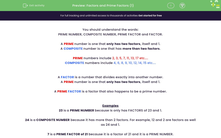You should understand the words:
PRIME NUMBER, COMPOSITE NUMBER, PRIME FACTOR and FACTOR.
A PRIME number is one that only has two factors, itself and 1.
A COMPOSITE number is one that has more than two factors.
PRIME numbers include 2, 3, 5, 7, 11, 13, 17 etc....
COMPOSITE numbers include 4, 6, 8, 9, 10, 12, 14, 15 etc....
A FACTOR is a number that divides exactly into another number.
A PRIME number is one that only has two factors, itself and 1.
A PRIME FACTOR is a factor that also happens to be a prime number.
Examples
23 is a PRIME NUMBER because is only has FACTORS of 23 and 1.
24 is a COMPOSITE NUMBER because it has more than 2 factors. For example, 12 and 2 are factors as well as 24 and 1.
7 is a PRIME FACTOR of 21 because it is a factor of 21 and it is a PRIME NUMBER.








